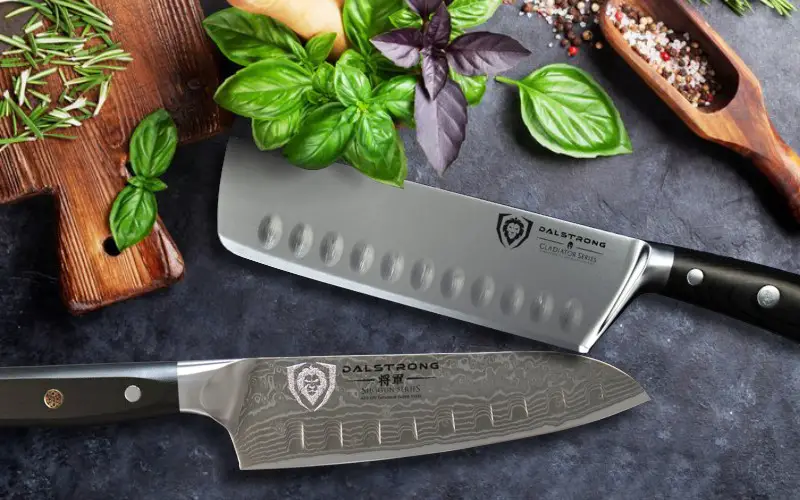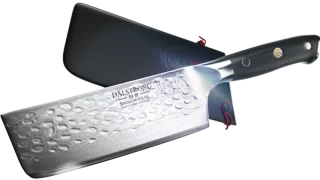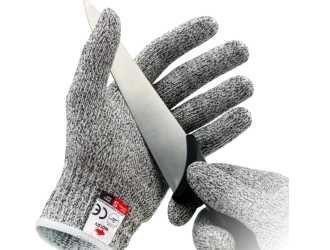
The original name of these knives in Japanese can give us an answer to the question of what these knives are for. Nakiri – 菜切り包丁 (Nakiri bocho) mean a knife for cutting greens, other words, it is a knife for vegetables. Santoku – 三徳包丁 (Santoku bocho) mean a knife for three uses.
However, it does not answer questions what is the difference between use and result. Santoku vs Nakiri – lets the challenge begin!
Nakiri vs Santoku – Nakiri Knife Review
The traditional Nakiri knife has a thin blade with a double beveled edge. It is ideal for chopping, mincing, and slicing vegetables and fruits. We see it by the name of the knife, Nakiri in Japanese can also be readen as „Na“– Leaf and „kiri“- Cutting.
The usual and the most common blade size is 6.5 to 7 inches. Knives of this size are strong enough for most operations and are still lightweight for comfortable use.
The Nakiri blade has Ryoba edge (from Japanese – both sides angled), which is very useful for making straight slices. It is very thin.
It seems to be impossible to break the vegetable slices with this blade.
The rectangular-shaped blade is tall enough to provide good control for tap chopping or push and pull cutting. In other words, there is enough space for your free hand to guide the blade.
In addition, the size of this blade gives space for the knuckles of the hand when you cut directly above a cutting board.
Dalstrong Nakiri Knife Best Vegetable Knife Review
Dalstrong Nakiri Asian Vegetable Knife from the Shogun collection is one of the best choices at the market. It has all the features of the Shogun collection and has the perfect blade relief, which is very necessary for cutting vegetables.
The air in the furrows of the knife will allow the slices not to stick to the blade. The knife is forged from a single piece of ultra-premium Japanese high carbon AUS10-V steel with 66 alternating layers of SUS410 Damascus cladding for stain-resistance and durability.
The blade is hand finished at a staggering 8-10° angle on each side using the traditional three-step Honbazuke method.
The next important part of the knife is the handle, Dalstrong Nakiri knife has a heat, cold, and moisture resistant handle. This means that it is durably enough to be inherited by your grandchildren. And most importantly – it is hygienic because there are no gaps between the blade and the handle.
Finally, it has a stainless steel end cap that adds the perfect counterbalance.
- Damascus steel
- Blade does not stick to food
- Lifetime Guarantee
- Great purchase or gift
- Not a multitask knife
Final Verdict
Dalstrong Nakiri is a well-balanced knife made using the latest technologies based on the Japanese traditions. Each piece is a unique representative of true masterpiece.
It is the best choice for the Nakiri knife and it is suitable for those who cut huge amounts of vegetables, fruits, and greens.
Santoku vs Nakiri – Santoku Knife Review
As mentioned at the beginning, Santoku, translated from Japanese, means “three uses”, a common understanding of these words, that this knife covers three cutting tasks: slicing, dicing and mincing. More accurate reading means that the knife performs well with slicing fish, mincing meat and dicing vegetable.
The standard length of Santoku knife is 6-7 inch. The blade may have a Kataba edge (for professional use) or a Ryoba edge (most common) with a total angle of 20 to 30 degrees or 10 to 15 degrees on one side.
Sometimes you can find a Santoku knife with an edge of blade less than 10 degrees from one side (only the Kataba edge is used), which is probably more difficult to use and require additional skills. But as a result, it gives very thin slices that are very common in traditional Japanese cuisine.
To be strong enough, genuine Santoku knives made from Damascus steel, typically use 50 or more layers of steel, which are then forged to produce a high-quality blade.
The Santoku cutting technique is a movement from back-up to down-front that provides a more linear cutting edge.
The Santoku blade and handle are designed to work in harmony by matching the blade’s width/weight to the weight of blade tang and handle.
Dalstrong Santoku Knife Best Multitask Knife Review
The ideal solution for the kitchen is Santoku by Dalstrong. This is a professional knife at an affordable price. Dalstrong Santoku will provide you with high performance and class right from the package.
This knife is made of high-quality Japanese steel, its blade is forged from one piece consisting of 66 layers of steel. Its razor-sharp blade will definitely amaze you.
For best performance, the knife has the perfect balance and gently tapers with rock hollows (rectangular divots on the sides of the blade). It is designed to maximize the number of air pockets and minimize the stuck of food.
The handle is ultra-premium G-10 Garolite, what mean that it is very impermeable to heat, cold, moisture and impact. It has military grade strength and life-long durability.
The blade and handle together have the right contours and a seamless construction that eliminate food and dirt holes to provide maximum hygiene and safety.
- Durable
- Well Balanced
- Triple-riveted for further agility
- Professional performance
- Lifetime guarantee
- Extremely sharp, must be very accurate
Final Verdict
Great multi-tasking knife with a professional performance. A good choice as the first professional knife for your kitchen, which will replace your old knives.
Nakiri vs Santoku – Buyer’s Guide
Contents:
Nakiri or Santoku: Whose Efficiency is Higher?
Both knives are great in their specialization, what in fact is their main difference.
While the Nakiri knife was created specifically to solve task-related to greens and fruits, Santoku was made as a multifunctional knife.
As a result, Nakiri is best suited for cutting vegetables, fruits and greens, but not suitable for other tasks. Santoku performs many tasks, but some of them can be done better with other knives.
Santoku or Nakiri: What is The Most Convenient?
In general, both have excellent blade and handle designs that are well balanced and best for each other.
The difference between these two is considered in two things.
The first is very close to a previous question about tasks because different cutting techniques are used for different tasks, for example, Santoku is very convenient for rocking motion. Thus, Nakiri is best suited for tap chopping.
The second thing goes deeper into the details and may depend on the size of the knife.
Comparing the same size, the weight of Nakiri is usually higher than that of Santoku. The reason for this is a wider blade, in fact, it is not a problem, because the knife is still well balanced. However, you can feel the difference.
Nakiri Knife vs Santoku Knife: Any Other Options?
Santoku vs Chef Knife – What is the difference between a chef’s knife and a Santoku knife?
Santoku is usually in competes with European Chef Knife. In general, these two are different interpretations of general-purpose knives from Japan and Europe, there are very similar and different at the same time. If you don’t know which one to choose keep in mind that they have different cutting techniques.
Nakiri knife has more competitors, the most common are Usaba knife and Chinese Cleaver.
Usaba vs Nakiri – What is the difference between Nakiri and Usaba?
Nakiri vs Usaba – the main difference lies in the edge of the blade, while Nakiri has Ryoba edge, Usaba for usual has Kataba edge. Both are made for vegetables and greens, but Usaba may have a thinner blade, which makes it more efficient but also difficult to use.
Cleaver vs Nakiri – What is the difference between Cleaver and Nakiri?
Nakiri vs Chinese Cleaver – Chinese Cleaver can go in large sizes, it also has a thicker blade that affects its weight. As a result, Chinese Cleaver is more suitable for heavy chopping and deals greatly with bones.
Care of The Knife
The first step is to read the instructions and the knife care label after purchase. This is very important, because in most cases, the better you take care of the knife, the higher its efficiency and durability.
To extend the life of your knife, I recommend having a small kitchen towel on hand and wiping the blade after each use. Watch a video on YouTube how professional chefs work, and you will notice that they very often they wipe the blade after each cut or product change.
This will not only prolong the life of the knife, but also prevent the mixing of different products while you are cutting them.
And don’t forget to practice frequently honing. How to do it correctly read below.
Honing and Sharpening a Knife
These two actions will help you have an ultra-sharp knife every day. In fact, these are different procedures, while honing done more frequently to re-align the edge of the blade, sharpening removes steel to form a new edge.
The first rule – is to use materials made by the manufacturer of your knife, if it is made of steel.
The fact is that in the production the same steel is used for blades and sharpeners or honing rods, in pair they will work like no other combination.
The second rule – follow the manufacturer’s instructions, for example, for Dalstrong knives the company recommends using 8mm honing rods and wet stones for sharpening.
Imagine that you did not read the instructions and used a 10-mm rod instead of an 8-mm rod, as a result, you ruin the teeth on your bread knife.
For a better sharpening of your Dalstrong knife, it is better to use wet stones with a medium grit (#1000) for sharpening and fine grain (#6000) for finishing. Here is a GREAT OFFER.
The detailed instruction on how to sharpen the knife.
Terminologies
Kataba Edge – the blade is sharpened on one side only. Can be sharpened for both the right and left hand.
Ryoba Edge – blade sharpened on both sides.
G-10 Garolite – is a high-pressure fiberglass laminate that is favored for its high strength, low moisture absorption, excellent electrical and chemical resistance.
Honbazuke Method – is a traditional Japanese sharpening method, when the blade is first coarsely ground with a vertically rotating sharpening stone. At the second stage, a fine honing using a horizontally rotating sharpening stone follows it. Finally, the edge is polished using a leather-stropping block for scalpel-like sharpness.
AUS10-V steel – stainless steel produced by Japanese Aichi Steel Corporation. The blades of this steel have high wear resistance, toughness, and ease of sharpening. This type of steel remains above the 400th series of steel, which is most popular for the production of knives.
Safe
Working with sharp instruments and tools is always a risk, and you should be careful when using them.
Here are some guidelines for making your work safer.
- Make sure your cutting board does not move while cutting. To secure your cutting board, you can put a thin towel under it.
- Do not try to cut quickly if you are using a new cutting technique, take enough time to practice at a comfortable speed.
- Never keep the knife in a drawer with other tools in the mix, especially do not hold it up the blade.
Final Verdict
Santoku knife vs Nakiri knife, there is no answer which one is better because they both have different tasks. Nakiri is perfect for cutting vegetables, fruits, and greens, and if you are cooking a lot of it, this knife will probably be one of the most popular in your kitchen.
If you are looking for the first professional knife, it is better to choose Santoku, because it is a multifunctional knife and a good start to get acquainted with high-performance knives.





